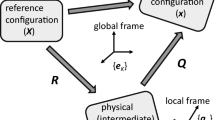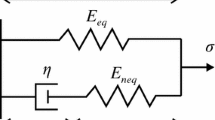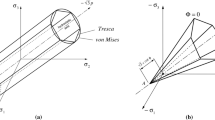Conclusions
The transformation field analysis is a general method for solving inelastic deformation and other incremental problems in heterogeneous media with many interacting inhomogeneities. The various unit cell models, or the corrected inelastic self-consistent or Mori-Tanaka fomulations, the so-called Eshelby method, and the Eshelby tensor itself are all seen as special cases of this more general approach. The method easily accommodates any uniform overall loading path, inelastic constitutive equation and micromechanical model. The model geometries are incorporated through the mechanical transformation influence functions or concentration factor tensors which are derived from elastic solutions for the chosen model and phase elastic moduli. Thus, there is no need to solve inelastic boundary value or inclusion problems, indeed such solutions are typically associated with erroneous procedures that violate (62); this was discussed by Dvorak (1992). In comparison with the finite element method in unit cell model solutions, the present method is more efficient for cruder mesches. Moreover, there is no need to implement inelastic constitutive equations into a finite element program. An addition to the examples shown herein, the method can be applied to many other problems, such as those arising in active materials with eigenstrains induced by components made of shape memory alloys or other actuators. Progress has also been made in applications to electroelastic composites, and to problems involving damage development in multiphase solids. Finally, there is no conceptural obstacle to extending the approach beyond the analysis of representative volumes of composite materials, to arbitrarily loaded structures.
Similar content being viewed by others
References
Bahei-El-DinY. A. 1990: Plasticity analysis of fibrous composite laminates under thermomechanical loads. In: KennedyJ. M.; MoellerH. H.; JohnsonW. S. (ed.): Thermal and mechanical behavior of metal matrix and ceramic matrix composites. ASTM STP 1080: 20–39. American Society for Testing and Materials, Philadelphia, PA
Bahei-El-DinY. A.; ShahR. S.; DvorakG. J. 1991: Numerical analysis of the rate-dependent behavior of high temperature fibrous composites. In: SinghalS. N.; JonesW. F.; CruseT.; HerakovichC. T. (ed.) Mechanics of composites at elevated and cryogenic temperatures. ASME AMD 188: 67–78. American Society of Mechanical Engineers, New York, NY
BellmanR. E.; KalabaR. E.; LockettJ. A. 1966: Numerical inversion of the Laplace transform. Elsevier, New York
BenvenisteY. 1987: A new approach to the application of Mori-Tanaka's theory in composite materials. Mech. of Materials 6: 147–157
ChristensenR. M. 1971: Theory of viscoelasticity, an introduction. Academic Press, New York
ChristersenR. M. 1979. Mechanics of composite materials. John Wiley, New York
DafaliasY. F.; PopovE. P. 1976: Plastic internal variables formalism of cyclic plasticity. J. Appl. Mech. 43: 645–651
DvorakG. J. 1990: On uniform fields in heterogeneous media. Proc. R. Soc. Lond. A 431: 89–110
DvorakG. J. 1991: Plasticity theories for fibrous composite materials. In: EverettR. K.; ArsenaultR. J. (ed.): Metal matrix composites, Mechanisms and properties, vol. 2: 1–77. Academic Press, Boston
DvorakG. J. 1992: Transformation field analysis of inelastic composite materials. Proc. R. Soc. Lond. A 437: 311–327
DvorakG. J.; BenvenisteY. 1992: On transformation strains and uniform fields in multiphase elastic media. Proc. R. Soc. Lond. A 437: 291–310
DvorakG. J.; TeplyJ. L. 1985: Periodic hexagonal array models for plasticity analysis of composite materials. In: SawczukA.; BianchiV. (ed.): Plasticity today: Modeling, methods and applications, W. Olszak memorial volume, 623–642. Elsevier Science Publishers, Amsterdam
EisenbergM. A.; YenC. F. 1981: A theory of multiaxial anisotropic viscoplasticity. J. Appl. Mech. 48: 276–284
FindleyW. N.; LaiJ. S.; OnaranK. 1976: Creep and relaxation of nonlinear viscoelastic materials. North-Holland Publishing Co., Amsterdam
GearC. W. 1971: Numerical initial value problems in ordinary differential equations. Prentice-Hall, Englewood Cliffs, New jersey
HillR. 1963: Elastic properties of reinforced solids: Some theoretical principles. J. Mech. Phys. Solids. 11: 357–372
Hindmarsh, A. C. 1974: GEAR: Ordinary differential equations system solver. Lawrence Livermore Laboratory, Report UCID-30001, Revision 3.
JohnsonW. S.; MirdamadiM.; Bahei-El-DinY. A. 1993: Stress-strain analysis of a [0/90]2s titanium matrix laminate subjected to a generic hypersonic flight profile. J. Composites Technology and Research, 15: 297–303.
LawsN. 1973: On the thermostatics of composite materials. J. Mech. Phys. Solids. 21: 9–17
LevinV. M. 1967: Thermal expansion coefficients of heterogeneous materials. Mekhanika Tverdogo Tela. 2: 88–94, English Translation: Mech. of Solids. 11: 58–61
MoriT.; TanakaK. 1973: Average stress in matrix and average elastic energy of materials with misfitting inclusion. Acta Metal. 21: 571–574
Shah. R. S. 1991: Modeling and analysis of high temperature inelastic deformation in metal matrix composites. Ph.D. Thesis, Rensselaer Polytechnic Institute, Troy, New York
SkudraA. M.; AuzukalnsY. V. 1973: Creep and long-term strength of unidirectional reinforced plastics in compression. Polymer Mech. 6: 718–722
SloanS. W. 1987: Substepping schemes for the numerical integration of elastoplastic stress-strain relations. Int. J. Num. Meth. Engng. 24: 893–911
SternsteinS. S. 1977: Mechanical properties of glassy polymers. In: HermanH. (ed.): Treatise on Materials Science and Technology, vol. 10: part B 541–598. Academic Press, New York
SternsteinS. S.; HoT. C. 1972: Biaxial stress relaxation in glassy polymers: Polymethyl metchacrylate. J. Appl. Phys. 43: 4370–4383
TEplyJ. L.; DvorakG. J. 1988: Bounds on overall instantaneous properties of elastic-plastic composites. J. Mech. Phys. Solids 36: 29–58
WangY. M.; WengG. J. 1992: The influence of inclusion shape on the overall viscoelastic behavior of composites. J. Appl. Mech. 59: 510–518
Author information
Authors and Affiliations
Additional information
Communicated by S. N. Atluri, 4 September 1993
This work was supported by the Air Force Office of Scienctific Research, and by the Office of Naval Research
Rights and permissions
About this article
Cite this article
Dvorak, G.J., Wafa, A.M. & Bahei-El-Din, Y.A. Implementation of the transformation field analysis for inelastic composite materials. Computational Mechanics 14, 201–228 (1994). https://doi.org/10.1007/BF00370073
Issue Date:
DOI: https://doi.org/10.1007/BF00370073




